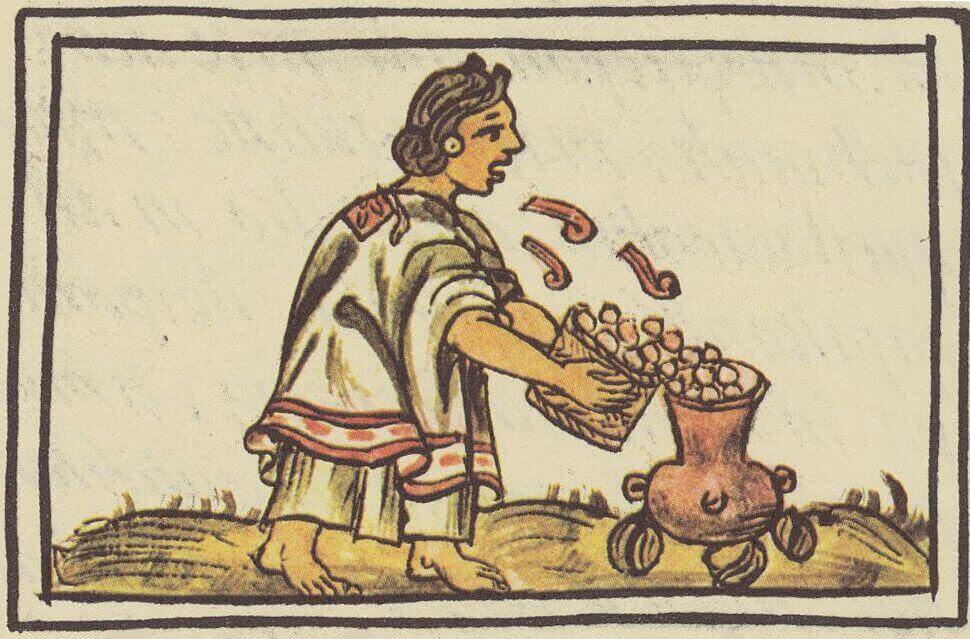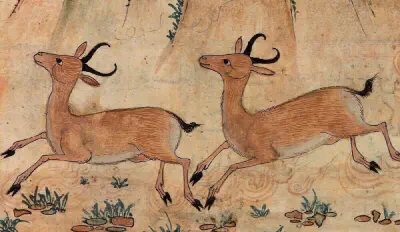The Aztecs and Philosophy
Who were the Aztecs?
The people now usually called the Aztecs were a Nahuatl-speaking people from Central Mexico. From the thirteenth century, their ancestors migrated from what is now Northern Mexico and the Southern United States to Mexico’s high central plateau. In the long political struggle for dominance that followed, the Aztecs eventually settled on a marshy, unprepossessing island in the middle of Lake Texcoco, where they began to build up a regional power base that became the foundation of one of the world’s greatest empires.
By 1519, when Hernán Cortés and his colonial Spanish army turned up at the Aztec capital of Tenochtitlan, the island city counted as one of the world’s largest, and was roughly four times the size of London. [1] But the arrival of the colonial powers was ruinous for Aztec culture. Cortés exploited internal disputes and divisions and formed a coalition of forces that laid siege to Tenochtitlan. And with the newly introduced horror of smallpox ravaging the population, within two years, the greatest city of the Aztecs had surrendered.
Nezahualcoyotl, the Aztec philosopher-king
Perhaps one of the greatest Aztec philosophers of the pre-colonial era was Nezahualcoyotl (1429-1472), whose name literally means “the coyote with a collar of fasting.” The collar of fasting, or nezahualli, was a braided collar worn by those undertaking a fast, as in indication they should not be offered food.
Nezahualcoyotl was a military general, a poet, a lawmaker, and a _tlamatinime _ (literally “one who knows”, __ or a sage).
Much of his philosophy was expressed in poetry that reflected on the brevity of human life. Here is an example:
I, Nezahualcoyotl, ask this:Is it true one really lives on the earth?Not forever on earth,only a little while here.Though it be jade it falls apart,though it be gold it wears away,though it be quetzal plumage it is torn asunder.Not forever on earth,only a little while here. [2]
Nezahualcoyotl was by all accounts a brutal ruler. But he was also a cultural reformer. He was a patron of the arts, and the force behind the development of the city of Tenochtitlan to its cultural heights. It is in part thanks to Nezahualcoyotl that, when the Spaniards arrived and saw the architectural marvels of Tenochtitlan, they were so astonished they apparently asked each other whether they were dreaming.
Philosophy
The poetry of Nezahualcoyotl has a keen sense of the transience and instability of the world. But this is not just a poet’s personal vision of life. Instead, it is a reflection of a much deeper philosophical view of life, one that was at the heart of Aztec culture and society.
Finding a footing
At the root of the Aztec understanding of human life is the idea that the world we inhabit, and our place in it, are both radically unstable. According to a common Nahuatl saying, “It is slippery, it is slick on the earth” (or in Nahuatl, “Tlaalahui, tlapetzcahui in tlalticpac”) [3]. When making our way through the world, it is as if we are navigating a high-up pathway that is slick with mud. Life is a dangerous itinerary, a pathway along which we always risk losing our footing.
This slipperiness, in the Aztec understanding, is the fundamental condition of the world. It is not just that the world is slippery for us; it is also slippery in itself. And the art of living is the art of maintaining a balance amid all this slipperiness.
In this understanding, it is all too easy to lose our balance and to fall into either moral wrongdoing or misfortune. And this is why we need wisdom: because wisdom is nothing other than learning what it means to maintain our balance.
This does not imply that the world is unremittingly awful: there is room for pleasure, for shared enjoyment of the world. But without vigilance and an appreciation of the changeable nature of the world, in the Aztec understanding, we will not thrive for long.
Teotl and becoming
Within Aztec thought, the underlying principle of everything is a single force or power called teotl. You could see teotl as a self-generating force or energy that is also the underlying stuff that makes up all reality. This energy is not personal—it is not God, even if it underpins the possibility of the existence of gods—nor is it an agent. It is sacred, meaning that the universe as a whole is also sacred, but it is impersonal.
The idea of teotl makes processes of change and flow fundamental to the world. In this view, the cosmos as a whole is self-generating and self-renewing. And the dynamism of teotl is why the world itself is such a slippery, uncertain and changeable thing. [4] It might be better to think about teotl not so much as a thing as a process. Or else, it can be useful to think—as James Maffie writes in his article on the Internet Encyclopedia of Philosophy—not so much of teotl as teotl-ising.
Motion-change
This idea of teotl gave Aztec thinkers an extraordinary sensitivity to the different kinds of change that take place in the world.
James Maffie talks about motion-change as a way of describing the different processes in this teotlising world. For the Aztec thinkers, there are three kinds of motion-change: olin, malinalli and nepantla. Olin is change that is repetitive, that pulsates and stretches and oscillates. It is, Maffie writes,
curving, swaying, oscillating, pulsating, and centering motion-change. It is exemplified by bouncing balls, pulsating hearts, respiring chests, earthquakes, labor contractions… [5]
Olin is all about equivocation, about coming-and-going. It is the bouncing of a ball. Or it is a pendulum swinging between extremes. It is the uncertainty we have when we are not sure what to do with ourselves. It is our gasping for breath when we have been for a run. And it is the struggle we have to find our equilibrium when the world is slippery.
In contrast to olin, malinalli is a kind of change that coils and binds and circles and whirls. It is the twisting together of threads to make ropes, the way that disparate-seeming things are bound together. It is,
twisting, spinning, gyrating, coiling, whirling, and spiraling motion-change. It is exemplified by spinning fiber into thread, cooking and digesting food, blowing life into things, drilling fire, burning incense, and ritual music, speech, and song. [6]
If we spin words and tunes into song, if we take this slippery material of the world and shape it and fashion it, then this is malinalli. The braided “fasting collar” or nezahualli from which Nezahualcoyotl took his name could also be seen as being fashioned by means of malinalli motion-change.
But the final—and most fundamental—kind of motion-change is nepantla. Again, Maffie writes,
Nepantla is middling, intermixing, and mutually reciprocating motion-change. It binds together… Nepantla motion-change is exemplified by mixing and shaking things together, weaving (interlacing), and sexual commingling. [7]
Nepantla is about how the world is woven together, how things are brought together and thereby transformed in new patterns and configurations. It is the constant generation and regeneration of an ordered fabric from this changeable cosmos.
Weaving the world
Within Aztec thought, although the world is inherently slippery, and there is an always-present risk of falling from the path, we are not therefore at the mercy of things. If we can understand these processes of change—olin, malinalli and nepantla—and if we can become a tlamatinime or a sage, we can manage to navigate the world and maintain a degree of balance.
For the thinkers of the Aztec world, wisdom is eminently practical: it is not about sitting back and contemplating the world. After all, how can you sit back and contemplate, when the world is so slippery that the moment you relax your guard, you are likely to fall from the path?
Instead, for the philosophers of the Aztec world, wisdom is about learning what it means to live in this pulsating, gyrating, twisting, spinning, intermixing cosmos. It means understanding more deeply the complexity of a changing cosmos that is teotl, to open up creative possibilities for how we go about our lives. When we can find our balance like this, then we can participate in the ongoing creativity of the universe, the ongoing weaving of the world-in-motion that is teotl. Again, James Maffie writes,
In the final analysis, teotl is simultaneously the weaver of reality, the weaving of reality, and woven reality itself. [8]
It takes skill and knowledge to come to terms with these processes of change. But when we have sufficient wisdom to really see the world’s instability and ambiguity, then we can work with it to weave a well-balanced life.
Notes
[1] There’s an excellent overview of the early history of the Aztecs in David Carrasco’s The Aztecs, A Very Short Introduction (Oxford University Press 2012).
[2] Miguel León-Portilla, Fifteen Poets of the Aztec World (Oklahoma University Press 1992), p.70
[3] The translation comes from Louise Burkhart, The Slippery Earth: Nahua-Christian Dialogue in Sixteenth-Century Mexico (University of Arizona Press 1989).
[4] James Maffie’s Aztec Philosophy: Understanding a World in Motion (University Press of Colorado 2014) gives a very detailed exploration of teotl and its role in Aztec metaphysics.
[5] Aztec Philosophy, p. 13
[6] ibid. p. 14
[7] ibid.
[8] ibid. p. 513
Further Reading
Books
Robert Eli Sanchez Jr’s Latin American and Latinx Philosophy: A Collaborative Introduction (Routledge 2020) is a good introduction.
Miguel León-Portilla’s Aztec Thought and Culture (Oklahoma University Press 2012) is also worth a read.
Online Resources
James Maffie’s excellent article on the IEP is well worth reading.
Lynn Sebastian Purcell’s blog from the APA is a beautifully clear introduction to some themes in Aztec philosophy. Read it here.
Image: Aztec woman blowing on maize (corn) before putting it into the cooking pot, so it will not fear the fire. Florentine Codex I, fol 347 right, Late 16th century. Public Domain via Wikimedia Commons. A good example of malinalli, both in the blowing and in the cooking!



